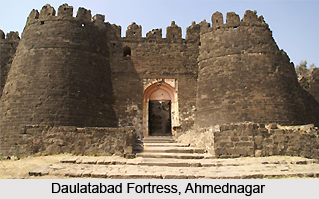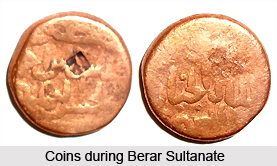 Deccan Sultanates ruled the south-western portions of India during the latter part of the medieval period, particularly in the areas of Berar, Ahmednagar, Golconda, Bijapur and Bidar. They were so named due to their geographical location, as they were based in the Deccan Plateau, in the region between the Vindhya Mountain Range and Krishna River. During the dissolution of the Bahmani Sultanate, these kingdoms of the Deccan asserted their independence. Ahmednagar was the first kingdom to declare independence in 1490. Berar and Bijapur followed suit, in the same year, while Golconda became an independent kingdom in the year 1518. Bidar gained independence in 1528. Bijapur checked an invasion by the Portuguese in the year 1510, against Goa. However, it was defeated the following year.
Deccan Sultanates ruled the south-western portions of India during the latter part of the medieval period, particularly in the areas of Berar, Ahmednagar, Golconda, Bijapur and Bidar. They were so named due to their geographical location, as they were based in the Deccan Plateau, in the region between the Vindhya Mountain Range and Krishna River. During the dissolution of the Bahmani Sultanate, these kingdoms of the Deccan asserted their independence. Ahmednagar was the first kingdom to declare independence in 1490. Berar and Bijapur followed suit, in the same year, while Golconda became an independent kingdom in the year 1518. Bidar gained independence in 1528. Bijapur checked an invasion by the Portuguese in the year 1510, against Goa. However, it was defeated the following year.
The empire of Vijayanagara was conquered by the Deccan Sultanates in the year 1565 at the Battle of Talikot, which weakened the foundations of this empire. They had laid a military coup in the region of Berar in the year 1574. Ahmednagar was eventually defeated. The rulers of Bijapur were able to annex the kingdom of Bidar in 1619. The Mughal Empire finally conquered the Deccan Sultanates, when Bidar was separated from Ahmednagar in the year 1596. Between the years 1616 and 1636, Ahmednagar was completely conquered by the Mughals while Bijapur and Golconda were defeated in the forceful campaign led by Aurangzeb in 1686 to 1687.
Ahmednagar Sultanate
On 28th May, 1490 the Nizam Shahi Dynasty was established in Ahmednagar after the Bahmani army was defeated by the governor of Junnar, Malik Ahmed Shah. In 1499, the fortress of Daulatabad was gained control, by him. Burhan, his son ascended the throne following his death in 1510. He ruled till 1553, when he finally died. Thereafter, Hussain Shah I succeeded him. However, he died in 1565 and was succeeded by his minor son Murtaza Shah. Khanzada Humayun Sultana, his mother ruled the kingdom while he was a minor, and until he occupied the throne in 1574. Miran Hussain, who was his son, ascended the throne in 1588 though he was poisoned to death after ten months.
Though Miran`s cousin Ismail ascended the throne, Jamal Khan controlled the reigns of the empire. In 1591, Jamal Khan was killed in the battle of Rohankhed and the throne passed into the hands of Burhan Khan. Ibrahim Shah became the new emperor after Burhan Shah`s death, who was killed in battle against the Bijapur Sultanate. Thereafter, Chand Bibi, Ibrahim`s aunt announced Bahadur Shah, the minor son of Ibrahim Shah as the new king and became his royal regent. Chand Bibi repulsed the Mughal invasions which were spearheaded by Murad in 1595, though her empire was conquered by the Mughal Empire in 1600, following her death. A new capital was founded at Paranda in the same year since Murtaza Shah II was declared the Sultan by some Ahmednagar officials, who dared to challenge the Mughals. In 1633, Fath Khan, the son of Malik Ambar surrendered to the Mughal Empire and sent Hussain Shah as a prisoner. However, Hussain helped Murtaza ascent the throne with the aide of Bijapur. Eventually, Aurangzeb annexed the Ahmednagar Sultanate after defeating Hussain Shah.

Berar Sultanate
During 1490, Fath-ullah Imad-ul-Mulk, the governor of Berar proclaimed independence and established the dynasty of Imad Shahi which belonged to the Berar Sultanate. Achalpur was made the capital. He had fortified Narnala and Gavilgad and was succeeded by Ala-ud-din, his eldest son in the year 1504. The invasion by rulers of Ahmednagar was repulsed by Ala-ud-din with the timely help of the sultan of Gujarat, Bahadur Shah in 1528. Sultan Darya made an attempt to enter into an alliance with Bijapur but his efforts were in vain. Following his death in 1562, Burhan, his son ascended the throne. In the year 1574, Tufal Khan conspired against Burhan Imad Shah and had him removed from the throne. The then Sultan of Ahmednagar, Murtaza I annexed this region to his own Sultanate the very same year.
Bidar Sultanate
Qasim Barid became the `mir jumla` of the Bahmani Sultanate in 1492. He had established the Barid Shahi Dynasty. He ruled till 1504. Amir Barid, his son supervised the empire after the death of Qasim Barid. Amir Birad began his independent rule from 1528 onwards, after Kalimullah, the last Bahmani ruler retreated from Bidar. Ali Barid, the son of Amir Barid assumed the prestigious title of `Shah` after Amir`s death. Amir Barid Shah III, who was the final emperor of Bidar Sultanate, lost to the Bijapur Sultanate in the year 1619.
Bijapur Sultanate
Adil Shahi Dynasty ruled over the Bijapur Sultanate from the year 1490 till 1686 and they were the provincial emperors of the Bahmani Sultanate. Isamail Adil Shah founded an independent sultanate post-1518. His empire was existent near the Western Ghats, which was marked by the area on the southern portion of Maharashtra and the northern part of Karnataka. The Vijayanagara empire was established by the Adil Shahi dynasty which was located on the southern part of Tungabhadra River. In the year 1565, the army of Bijapur Sultanate defeated Vijayanagara and the empire became broke up soon afterwards. The area of Raichur-Doab was invaded by the Bijapur Sultanate in 1565. During the 17th century, the Marathas rebelled against the Bijapur Sultanate, under the leadership of Chhatrapati Shivaji. Finally, Aurangzeb was capable of conquering the kingdom of Bijapur in 1686, which brought about its subsequent decline.
Golconda Sultanate
Sultan Quli Qutub-ul-Mulk, who was the founder of the Golconda Sultanate shifted to Delhi along with his friends and family members in the 16th century. He rendered his services to Mohammed Shah, a Bahmani Sultan when he migrated to the Deccan. Soon after, he attacked Golconda and proclaimed himself the Governor of Telangana in 1518. After asserting independence from the Bahmani Sultanate, he assumed the title of `Qutb Shah` and founded the dynasty of Qutab Shahi in the region of Golconda. Their dynasty continued its regime for 171 long years, till it was conquered by Aurangzeb in 1687.






































